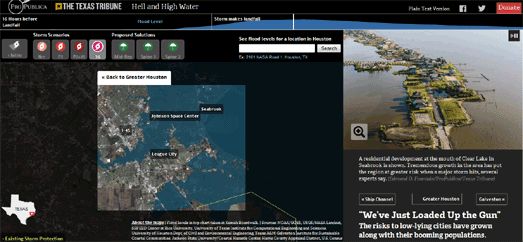 Houston buildings flooded in the 2015 Memorial Day Floods and in the 2016 Tax Day Floods
Houston buildings flooded in the 2015 Memorial Day Floods and in the 2016 Tax Day Floods
The city of Houston has three major problems: global warming, geography and deregulation. All three problems were brilliantly illustrated by ProPublica & the Texas Tribune last year in their series on Houston's Flood Risk.
One article in this series,
Boomtown, Flood Town, pointed out that (even before this year's disastrous flooding) some parts of Houston had been flooded three times in eight years. Politicians and city leaders in Houston seem very keen to portray this year's flooding as a once in a century event. The scale of this year's storm may well be unprecedented but Houston is becoming all too used to flooding.
In less than three years Houston has suffered from the 2015 Memorial Day Floods, the 2016 Tax Day Floods and now from the flooding caused by Hurricane Harvey. Even the most ardent climate change denier must acknowledge that flooding in Houston is becoming almost an annual event. The authors of Boomtown, Flood Town argue that "climate change is causing torrential rainfall to happen more often, meaning storms that used to be considered 'once-in-a-lifetime' events are happening with greater frequency."
One reason that city leaders might be so keen to blame 'once in a lifetime' events for the city's flood problems is that they have increased the risk and damage caused by flooding by encouraging deregulation. As Boomtown, Flood Town points out the huge growth of Houston has been encouraged by politicians who have been eradicating proper building and environmental regulations, "allowing developers to pave over crucial acres of prairie land that once absorbed huge amounts of rainwater."
Which leads us to one of Houston's other main problems - geography. Houston is built upon a swamp. The Houston Chronicle's article,
The Trouble with Living in a Swamp, explains how the city was built by drainage and exists only because of the 2,500 miles of managed waterways that help drain water out into the sea.
However Houston's natural flood defenses are fast being eradicated. The Boomtown, Flood Town authors say that "almost 30 percent of freshwater wetlands were lost between 1992 and 2010". At the same time "impervious surface in Harris County increased by 25 percent from 1996 to 2011". Where once freshwater wetlands served to prevent flooding Houston now has impervious surfaces, which only help to worsen the effects of localized flooding.

Another article in the Houston's Flood Risk series was
Hell and High Water. In this mapped visualization the author's warned of the dangers Houston faced from a future hurricane. The mapped interactive in the article simulates the likely effects of a number of potential storms on the city of Houston. Each of these simulations overlays the track of a potential storm over a satellite view of the city. These tracks are then animated to show the likely flooding events that could take place in Houston if such a storm hit the city.
Of course that storm has now hit the city. It was called Hurricane Harvey.
The article argues that not enough has been done to protect the city from potential future storms. Dr. Bill Merrell, a marine scientist at Texas A&M University, believes that the city needs to build floodgates at the entrance to Galveston Bay. He predicts something will be built - four years
after the next devastating hurricane. Well Houston has now had that devastating hurricane so lets see if those floodgates get built.
Luckily for Houston America now has a president who believes in infrastructure. President Trump is visiting the city on Tuesday. He will presumably use the opportunity to announce his government's financial support so that the city of Houston can finally build adequate flood defenses. He will no doubt also use the visit to renounce his support for deregulation and to finally support international efforts to fight climate change.



















































